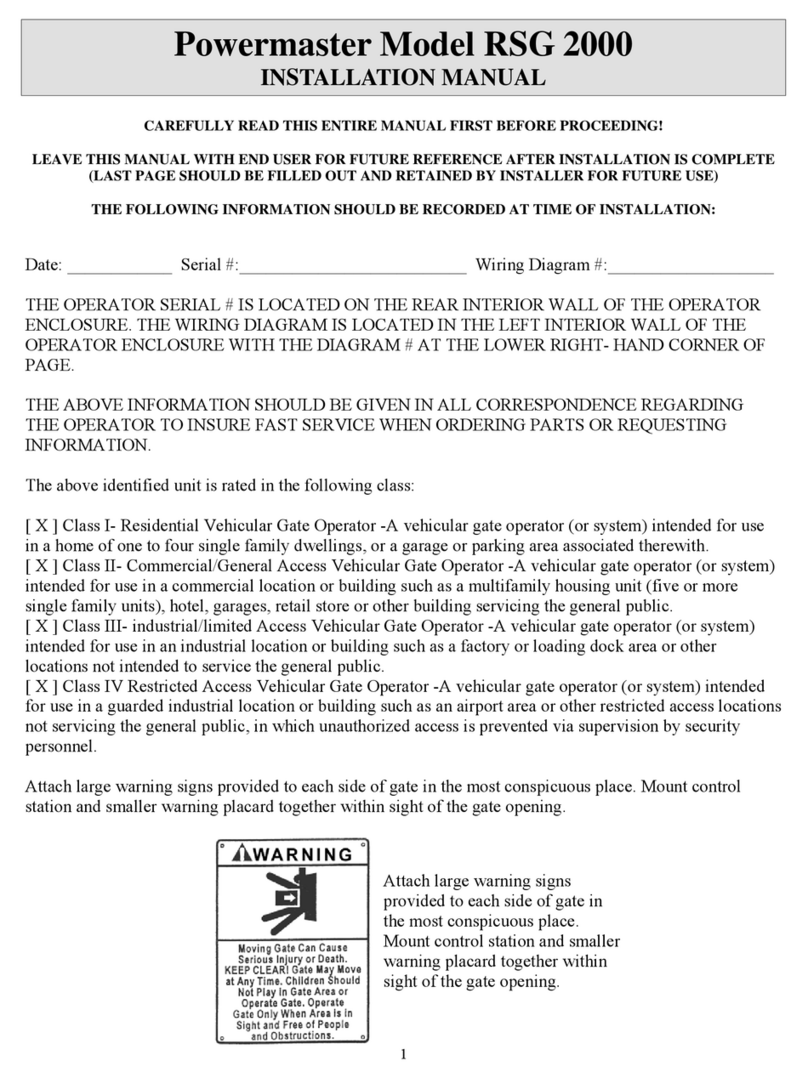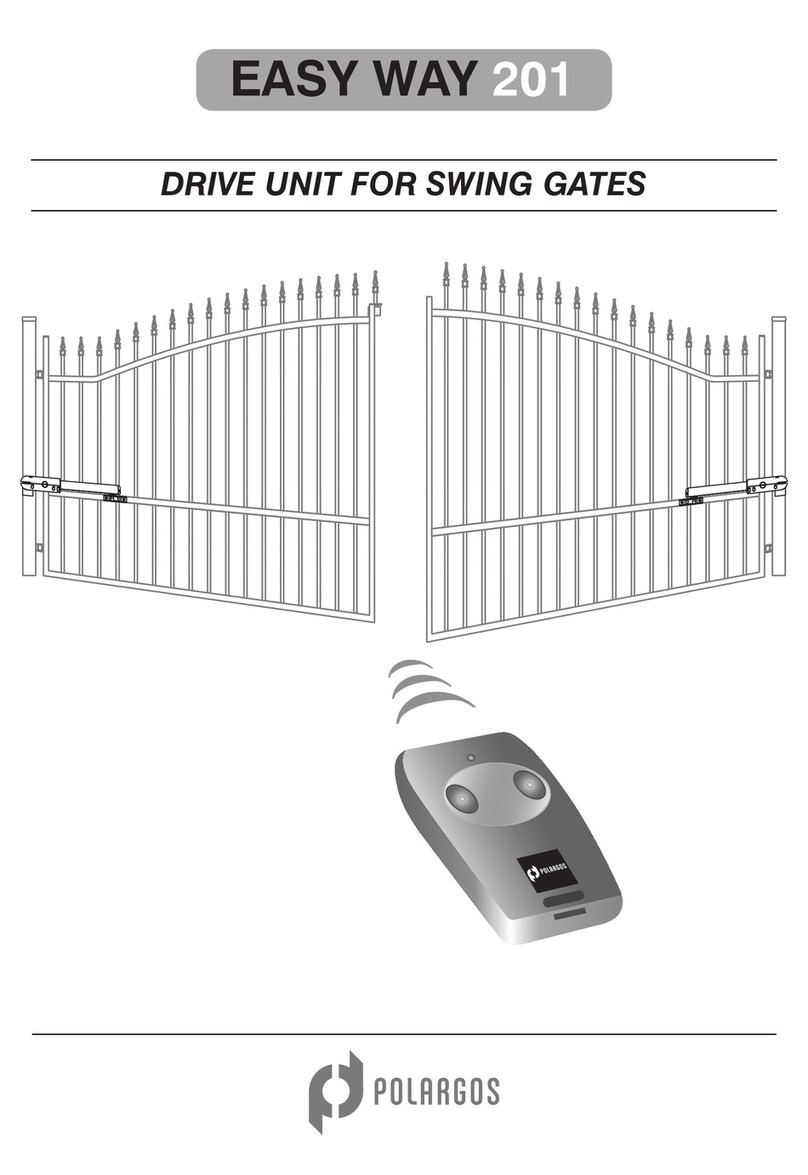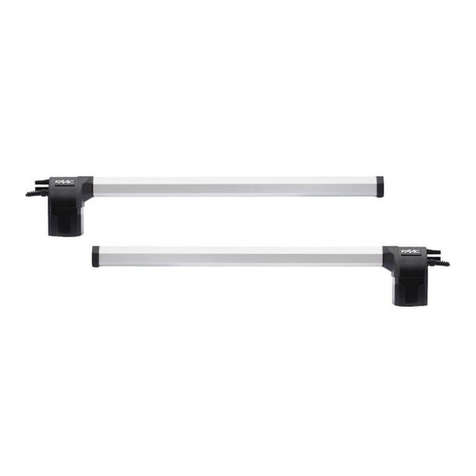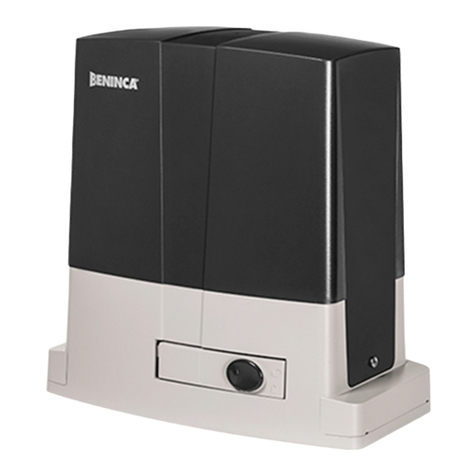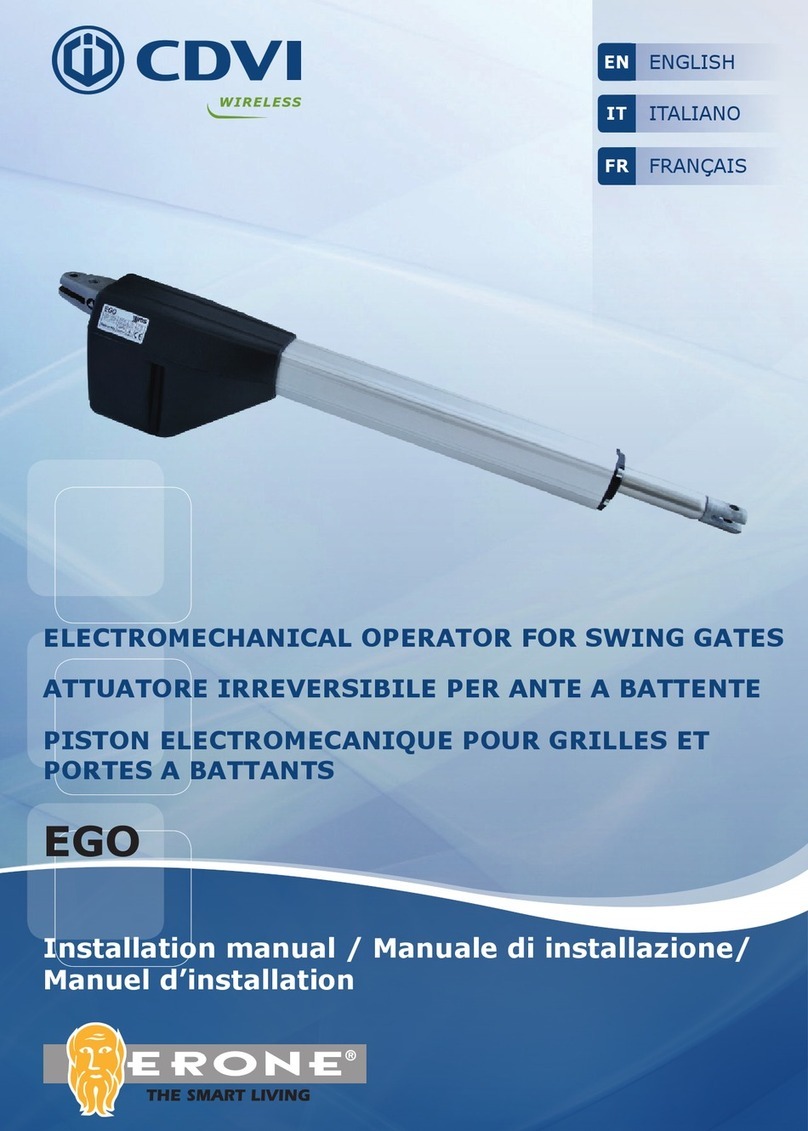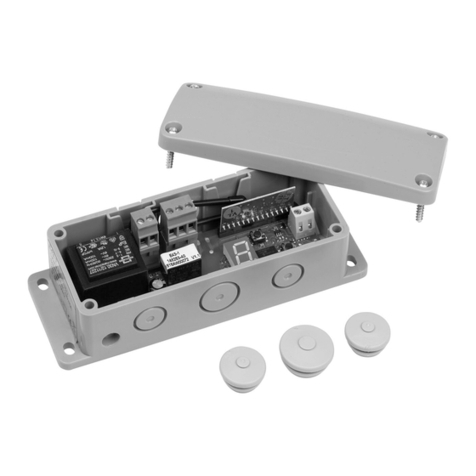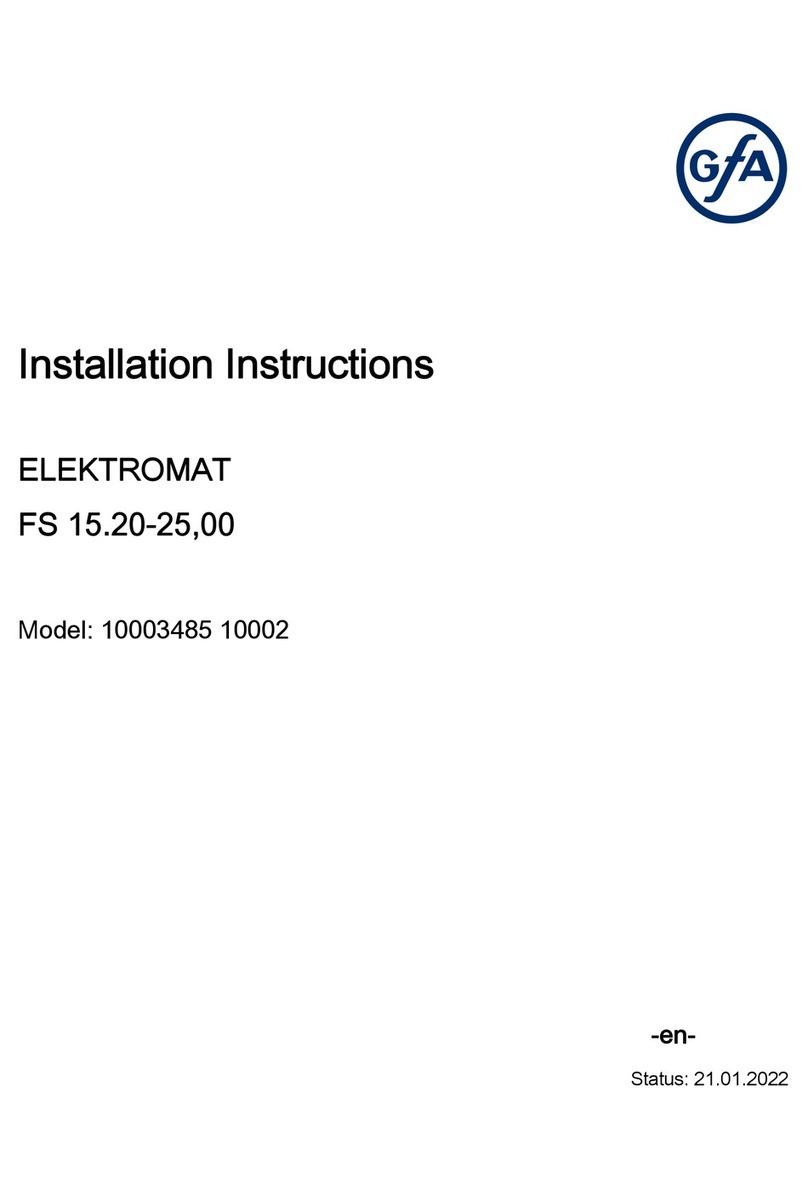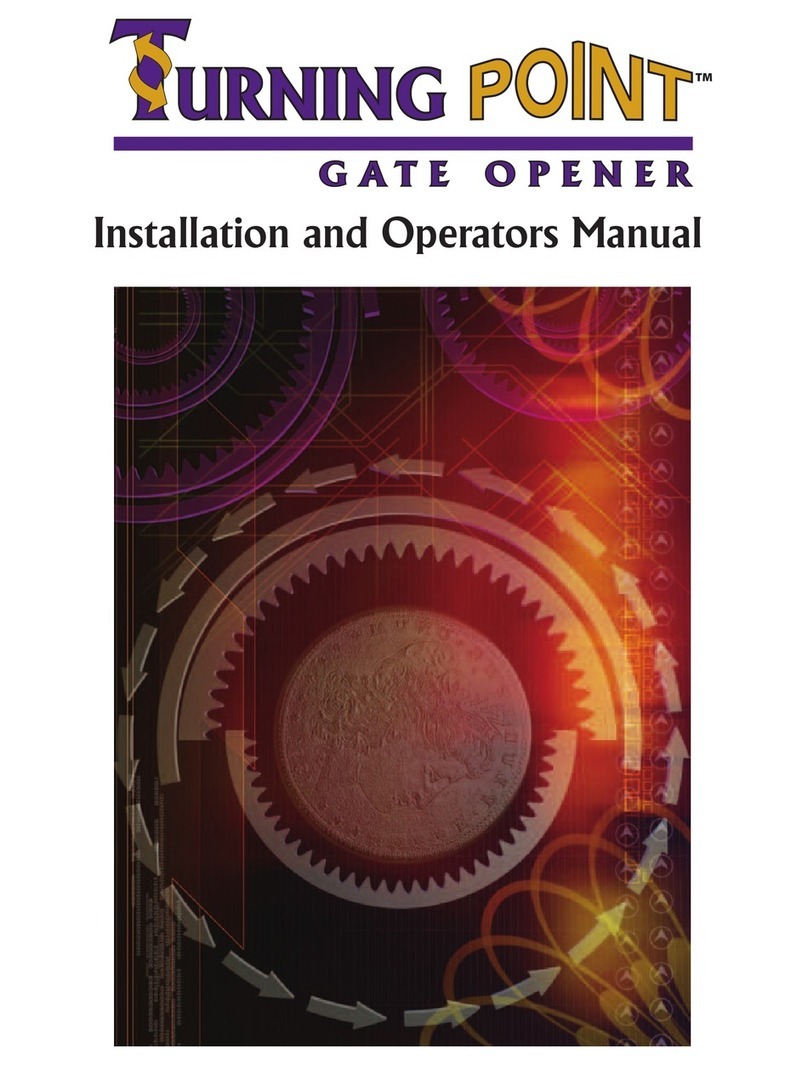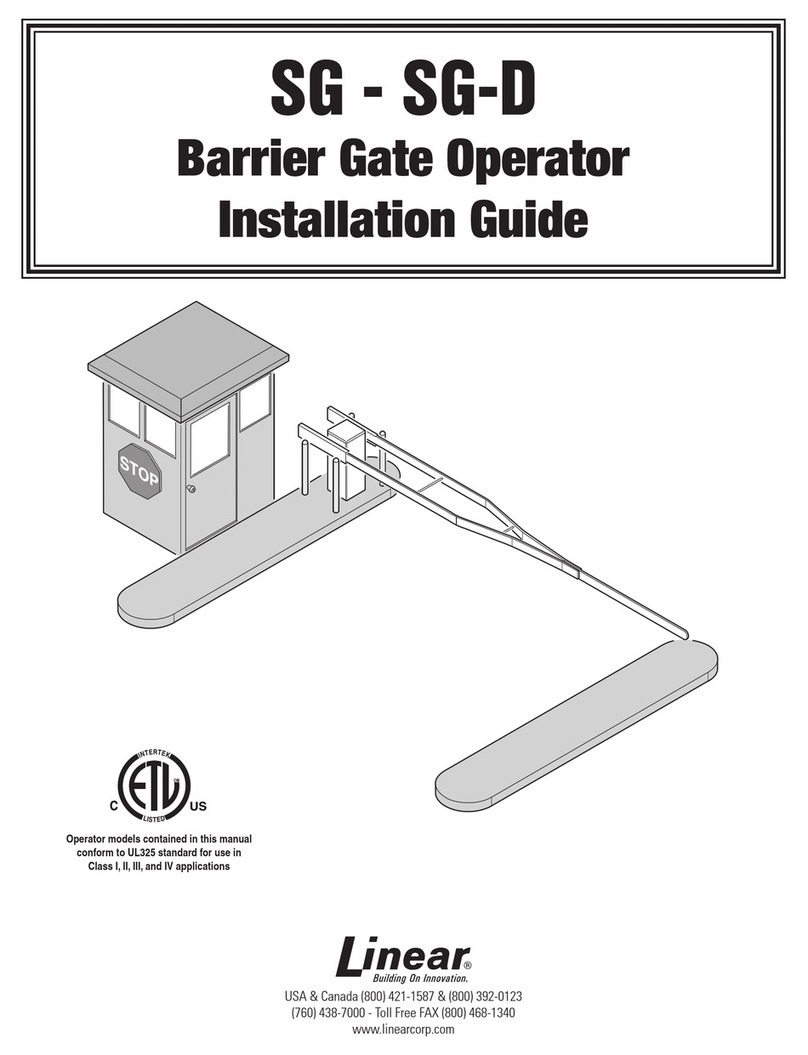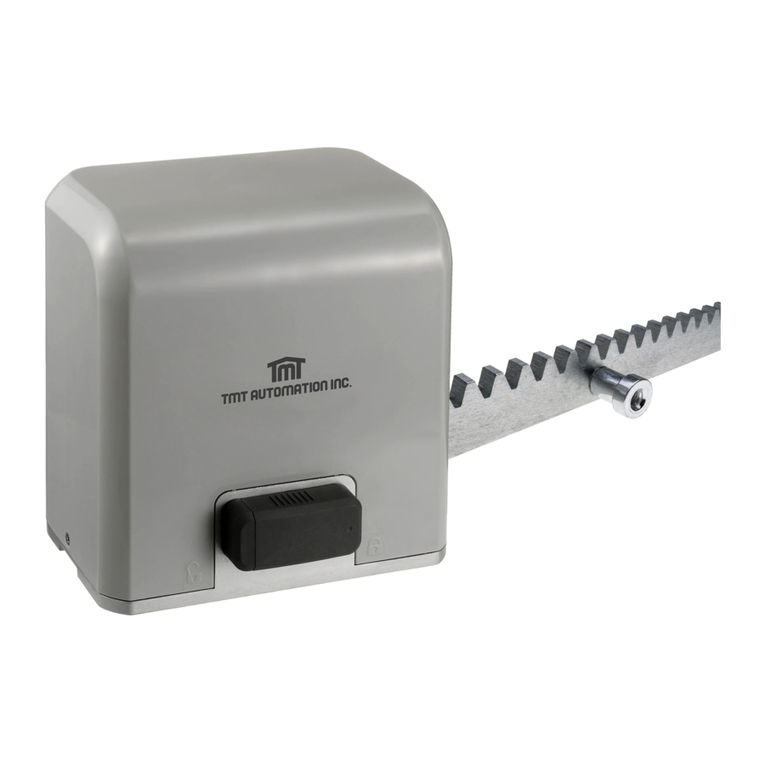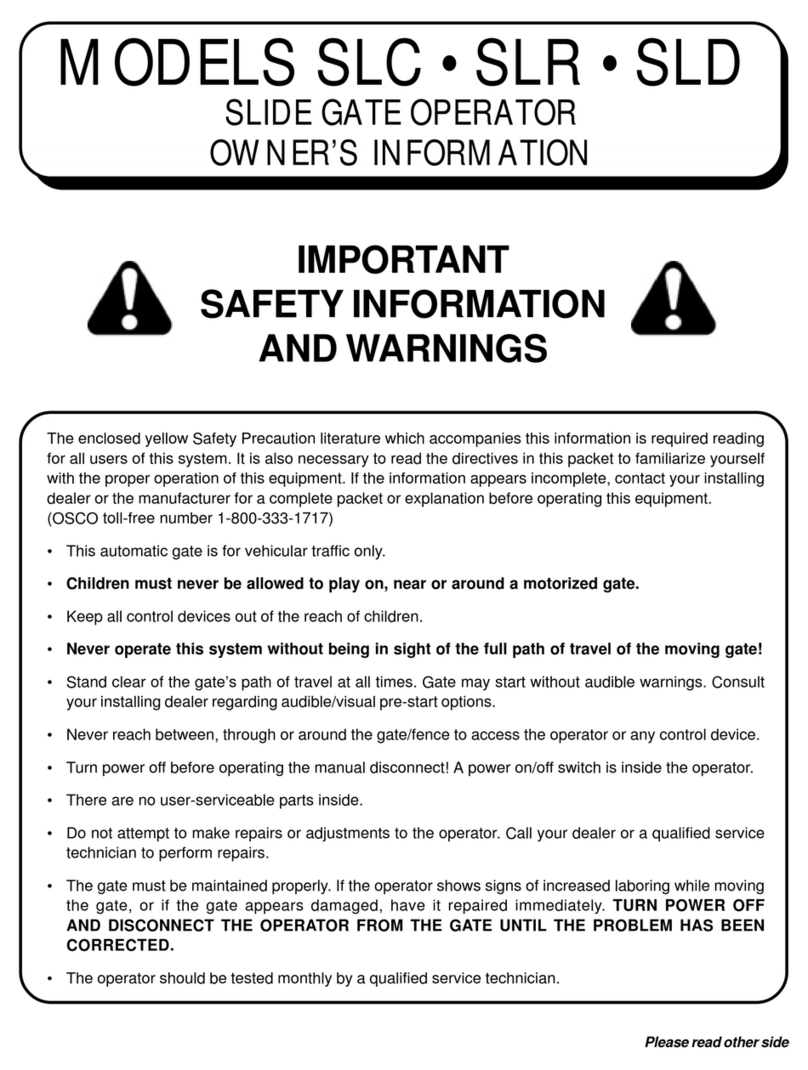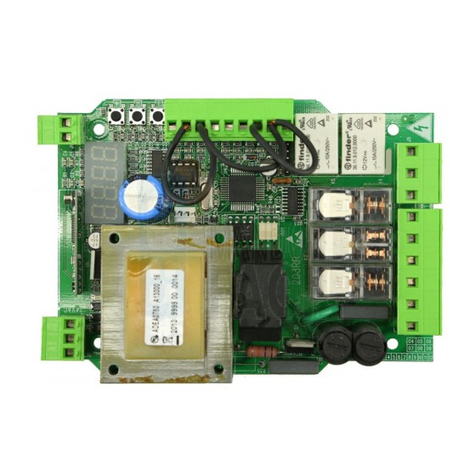Power Master rsw Installation instructions

21 1/2"
14 5/ 8''
12 1/ 8''
16 1/ 4''
19 1/ 4'' LENGTH X 10 1/ 2'' WIDTH 2'' O.D. PIPE
( BY OTHERS )
INSTALLATION AND OWNER’S MANUAL
MODEL RSW
Swing Gate Operator
UL 325 and UL 991 Listed
READ THIS MANUAL CAREFULLY
BEFORE INSTALLATION OR USE.
SAVE THESE INSTRUCTIONS.
Serial #:
Date Installed:
Your Dealer:

Important Safety Information ..................................................................................3
Important Notice for Gate Operators Manufactured after 1/11/16 ..........................4
UL Installation and Safety Considerations..............................................................5
System Designer Safety Instructions......................................................................6
Installer Safety Instructions ................................................................................ 7-8
End User Safety Warnings ............................................................................... 9-10
Manual Operation.................................................................................................11
Installation & Setup Procedure
Before Installing Operator.................................................................................11
Installation Layout.............................................................................................12
Installation of Operator ............................................................................... 13-14
Electrical Connections ......................................................................................15
Left Hand/Right Hand Conversion ....................................................................16
Connection of a 3-Button Station......................................................................16
Limit Adjustment ...............................................................................................17
Master/Slave Installation...................................................................................18
Timer to Close...................................................................................................18
Accessory Connections
Connection of a Radio ......................................................................................18
Loop Detector Systems .............................................................................. 18-21
Loop Installation (Standard Layout Chart) ........................................................19
Cutting the Required Groove ............................................................................19
Loop Connections....................................................................................... 20-21
Safety Device Connections
Inherent Obstruction Sensing Device ...............................................................21
Secondary Obstruction Sensing Devices ................................................... 22-24
Contact - Sensing Edge ...............................................................................22
Non-contact - Photo Eyes ............................................................................23
Warranty ..............................................................................................................27
Table of Contents
Model RSW Residential Swing Gate Operator

3
Automatic gate operators provide convenience and
security to users. However, because these machines
can produce high levels of force, it is important that all
gate operator system designers, installers, and end
users be aware of the potential hazards associated
with improperly designed, installed, or maintained
systems. Keep in mind that the gate operator is a
component part of a total gate operating system.
The following information contains various safety
precautions and warnings for the system designer,
installer and end user. These instructions provide an
overview of the importance of safe design, installation,
and use.
Warnings are identied with the ▲symbol. This symbol
will identify some of the conditions that can result in
serious injury or death. Take time to carefully read
and follow these precautions and other important
information provided to help ensure safe system
design, installation and use.
▲WARNING: Gate operators are only one part of a
total gate operating system. It is the responsibility of
purchaser, designer, and installer to ensure that the
total system is safe for its intended use. All secondary
entrapment safety devices must be RECOGNIZED
by UL to ensure the safety of the complete operating
system.
IMPORTANT!
FOR SWING GATE OPERATING SYSTEMS,
SAFETY IS EVERYONE’S BUSINESS.

4
IMPORTANT NOTICE FOR GATE OPERATORS
MANUFACTURED AFTER JANUARY 11TH, 2016
All gate operators manufactured after January 11th, 2016 must have a
monitored input for each direction. In order to satisfy this requirement,
all PowerMaster gate operators with the universal board will have one
monitored input for each direction. The close photo (11) terminal will
function for the close direction and the open photo (10) will function
for the open direction. These terminals will look for, or “monitor”, the
presence of a 10k in-line resistor. If either terminal does not detect the
presence of the monitored device, the unit will function in constant
contact for this direction.
Note: The rst time a monitored device is added to the unit, the board
must “learn” what the monitored device is. To have the board learn the
monitored device, perform the following steps:
1. With the power o, hold both the open and close limit
simultaneously.
2. Power up the unit and release your ngers from the limits. The
unit has now learned the monitored device.
E.g. The operator detects there is a monitored device on the 11 terminal
but not the 10 terminal. The operator will function in momentary
contact to close and constant pressure to open.
Following are the monitored devices acceptable for use with the
GSMCB02:
Any actions taken to circumvent this monitoring are in violation of the
UL325, building code, and local laws.
Device Manufacturer Description
Prime-Guard Miller Edge Monitored Photoeye
Reecti-Guard Miller Edge Retroreective Monitored Photoeye
IRB-MON EMX Monitored Photoeye
IRB-RET EMX Retroreective Monitored Photoeye
The Solution Miller Edge Multiple Safety Devices

5
UL INSTALLATION AND SAFETY CONSIDERATIONS
INSTALLATION CLASSES
CLASS I - RESIDENTIAL VEHICULAR GATE
OPERATOR
A vehicular gate operator (or system)
intended for use in a home of one
to four single-family dwellings, or a
garage or parking area associated
therewith.
CLASS II – COMMERCIAL/GENERAL ACCESS VEHICULAR GATE OPERATOR
A vehicular gate operator (or
system) intended for use in a
commercial location or building
such as a multifamily housing unit
(ve or more single family units),
hotel, garages, retail store or other
building servicing the general
public.
CLASS III - INDUSTRIAL/LIMITED ACCESS
VEHICULAR GATE OPERATOR
A vehicular gate operator (or system)
intended for use in an industrial
location or building such as a factory
or loading dock area or other locations
not intended to service the general
public.
CLASS IV - RESTRICTED ACCESS VEHICULAR GATE OPERATOR
A vehicular gate operator (or system)
intended for use in a guarded industrial
location or building such as an airport
area or other restricted access locations
not servicing the general public, in which
unauthorized access is prevented via
supervision by security personnel.

6
1. Familiarize yourself with the precautions and warnings for the installer. Users are
relying on your design to provide a safe installation.
2. The operator is supplied with a primary obstruction sensing entrapment protection
system. The installation must also have a secondary entrapment protection system
installed, such as photoelectric sensors or an electric edge system.
3. When designing a system that will be entered from a highway or main thoroughfare,
be sure the system is placed far enough away from the road to eliminate trac
backup. Distance from the road, size of the gate, usage levels, and gate cycle/speed
must be considered to eliminate potential trac hazards.
4. Swing gates have two potential entrapment zones you must avoid. Make sure they
are protected as shown in the following diagram (Figure 1).
5. Design the gate system so a person
cannot reach over, under, around,
or through the gate to operate any
controls. Never place controls on the
gate operator itself.
THIS GATE SYSTEM IS FOR VEHICULAR TRAFFIC ONLY. A
SEPARATE PEDESTRIAN ENTRANCE MUST BE PROVIDED.
WARNING
SYSTEM DESIGNER SAFETY INSTRUCTIONS
• Pedestrians should
keep clear of path
of gate, particularly
in the area before
fully closed.
• The area of the gate
arm and linkage
must be avoided
as it can create an
entrapment.
ENTRAPMENT ZONE
ENTRAPMENT ZONE
HORIZONTAL ELECTRIC EDGE, ON BOTTOM
OUTSIDE EDGE OF GATE. WIRED TO REVERSE
WHILE CLOSING (REQUIRED).
ELECTRIC EDGE, ON VERTICAL OUTSIDE
EDGE OF GATE. WIRED TO REVERSE
WHILE CLOSING (RECOMMENDED).
HORIZONTAL ELECTRIC EDGE, ON INSIDE
BOTTOM OF GATE. WIRED TO REVERSE WHILE
OPENING (RECOMMENDED).
1
2
FIGURE 1
▲
▲
▲
▲
▲
The illustrations and descriptive captions
provide precautions to help eliminate
injuries or fatalities. Familiarize yourself
with them when designing the total system.

7
INSTALLER SAFETY INSTRUCTIONS
BEFORE INSTALLATION
1. Check to see that the operator is proper for this type and size of gate and its frequency
of use. If you are not sure, consult factory.
2. Check to see that there are no structures adjacent to the area, which may pose a risk
of entrapment when gate is opening or closing.
3. You must ensure that the gate has been properly installed and works freely in
both directions. Replace or service any worn or damaged gate hardware prior to
installation. A freely moving gate will require less force to operate and enhance the
performance of the operator as well as the safety devices used within the system.
4. Install the gate operator on the inside of the property and/or fence line. DO NOT
install an operator on the public side of the gate.
5. Severe injury or death can result from entrapment by a gate. The operator is supplied
with an obstruction sensing primary entrapment protection system. Additional safety
equipment such as electric edges or photocell sensors must be installed to provide
the required secondary entrapment protection system. For assistance in selecting the
correct type of safety equipment, consult the factory.
6. Review the operation of the unit and become familiar with the manual operation
procedure and safety features of the system.
7. You must install a pushbutton control or key switch to allow for normal operation of
the gate if the automatic controls do not work. Locate the push button or key switch
and small warning placard within sight of the gate in a secured area at least 10 feet or
more from any moving parts of the gate or operator.
8. Outdoor or easily accessed gate controls should be of the security type to prohibit
unauthorized use. Please consult your local distributor concerning the types and
specications of available controls.
DURING INSTALLATION
1. Be aware of all moving parts and avoid close proximity to any pinch points.
2. Disconnect power at the control panel before making any electric service connections.
Connection location for controls and safety equipment can be found on the wiring
diagram, and in this manual.
3. Know the procedure for disengaging and manually operating the unit.
4. Adjust the open and close force adjustment on the control board, in each direction,
to the minimum force required to operate the gate smoothly. DO NOT increase the
force adjustment setting to make up for rough spots in gate travel - FIX THE GATE
INSTEAD!
▲
▲
▲
▲
▲
▲
▲
▲
▲
▲
▲
▲

8
5. Locate the controls
at least 10 feet from
the moving gate so
that the user can
observe the gate
operation, but is
not able to come
in contact with the
gate while operating
the controls.
6. Attach large warning
signs provided to
each side of the gate
or fence in the most
conspicuous place.
Mount control station
and smaller warning
placard together
within sight of the
gate opening.
AFTER INSTALLATION
You are responsible for ensuring that the end user understands the basic operations
and safety systems of the unit, INCLUDING THE MANUAL OPERATION PROCEDURE.
Point out that the safety instructions in brochure are the responsibility of the end user,
and then LEAVE THIS MANUAL WITH THE END USER.
Control
Station
10 feet
▲
▲
▲
▲
Moving Gate Can Cause
Serious Injury or Death.
KEEP CLEAR! Gate May Move
at Any Time. Children
Should Not Operate Gate.
Operate Gate Only When
Area is in Sight and Free of
People and Obstructions.

9
END USER SAFETY WARNINGS
The manufacturer of the gate operator does not know what type of gate you have, or what
type of automatic system is installed on your gate. Be sure you’ve been fully instructed
on the sequence of operation for your specic gate system(s). Keep the gate properly
maintained and have a qualied service person make repairs.
1. Be sure the following safety instructions
are distributed to all persons authorized
to use your gate.
2. KEEP GATEWAY CLEAR (Front and
Back) AT ALL TIMES. Your automatic
gate is not for pedestrian use. No
one should ever cross the path of the
moving gate.
3. DO NOT allow children to play near your
gate, or to operate the gate.
4. DO NOT operate your gate system
unless you can see it when the gate
moves.
5. Be sure a pushbutton or key switch
has been installed for manual electric
operation in the event your radio or
card key does not work. Any mounted
control station should be located a
minimum of 10 feet from the gate so
the gate cannot be reached through or
touched. Any pushbutton located in a
building should be installed within sight
of the gate.
6. DO NOT operate any controls without
watching the movement of the gate.
7. Your gate system is required to have a
primary and a secondary entrapment
safety system installed and maintained.
8. If your gate closes automatically, loop
detectors should be installed to detect
the presence of a vehicle.
▲
▲
▲
▲
▲
▲
▲
▲

10
9. DO NOT increase force adjustment to compensate for a damaged gate. The
gate should always be maintained to operate manually as easily as possible to
provide maximum protection.
10. Check all safety systems at least once per month for the correct force, speed
and sensitivity. Gate must reverse when hitting a rigid object, or when a
non-contact sensor is activated. If these functions are observed to operate
improperly, discontinue use and have it serviced immediately!
11. You are responsible for ensuring that warning signs are installed and
maintained on both sides of your gate.
12. To ensure safe operation of this equipment, you must read this safety manual
and keep it for reference.
13. Swing gates have two potential entrapment zones you must avoid. Make sure
they are protected as shown in Figure 1.
4’
MINIMUM
▲
▲
▲
▲
▲

11
INSTALLATION INSTRUCTIONS & SET-UP PROCEDURE
MANUAL OPERATION
BEFORE INSTALLING OPERATOR
IMPORTANT:Operator should always be mounted inside the gate. Determine
whether the installation is Left hand or Right hand by the direction the gate
moves in order to open, when viewed from inside the fence.
DO NOT APPLY POWER UNTIL TOLD TO DO SO! RISK
OF ELECTRICAL SHOCK OR INJURY MAY RESULT!
WARNING
Your operator is
equipped with an
emergency disconnect
for manual operation.
Be sure you know how
to properly use this
feature. To disengage
operator, follow the
procedure in Figure 2.
FIGURE 3
LEFT HAND INSTALLATION
FENCE FENCE
OPERATOR OPERATOR
HINGE HINGEGATE GATE
RIGHT HAND INSTALLATION
HAND KNOBS FOR MANUAL DISCONNECT
(USE HOLES SHOWN AS STARTING
POSITION)
CONTROL ARM
CONTROL ARM
EXTENSION
3/8” BOLT
3/8” LOCK WASHER
3/8” WASHER
1/4” DRIVE KEY
OPERATOR
DRIVE SHAFT
FIGURE 2
1. Gate must swing freely to fully opened and fully closed position.
2. The operator will be located as shown above, for left and right hand installation.
NOTE: TO DISCONNECT OPERATOR FOR
MANUAL OPERATION, REMOVE HAND
KNOBS AND SEPARATE CONTROL ARM
EXTENSION FROM CONTROL ARM

12
INSTALLATION LAYOUT
1. Layout mounting post and electrical conduit locations as shown in gures below.
Excavate required area for conduit installation and cementing of mounting posts
(Minimum of 2 feet deep. Check local codes.)
2. Set mounting post and electrical conduit in place.
3. Pour cement to secure mounting posts and let cure for two days prior to operator
installation.
Note: Distance between mounting posts and relative location to gate is very
important! Operator must be installed perpendicular to the fence.
GATE HINGE
GROUND LEVEL
17-3/8”
21-1/2”
APPROX. 16”
24” MIN.
4” MIN.
28”
18”
2” O.D. (MOUNTING POST) BY OTHERS
CENTER LINE OF FENCE
ELECTRICAL ACCESS
SIDE COVER
ELECTRICAL CONDUIT
PER LOCAL CODE
ELECTRICAL
CONTUIT
TOP MOUNTING ANGLE
2” U-BOLTS
ELECTRIAL CONDUIT PER
LOCAL CODE
APPROX. 16”
24” MIN.
4” MIN.
21-1/2”
LOWER
MOUNTING
PLATE
SWING GATE OPERATOR
2” O.D. (MOUNTING POST)
BY OTHERS
FIGURE 5
FIGURE 4

13
OPERATOR INSTALLATION
1. Mount operator on posts with mounting angles and mounting plates. Secure position
with 2” U-bolts and hardware provided. See Figure 5.
2. Set control arm on output shaft of operator without drive key, and install control arm
extension using hand knobs to secure position. See Figure 6.
3. Install end ttings
on connecting rod
assembly and attach one
end of assembly to end
of control arm extension.
See Figure 7.
4. Install gate bracket on
remaining end of connecting
rod (See Figures 7 & 8)
5. Locate gate bracket in position
on gate, as shown in Figure 8
and clamp in position.
6. Move control arm to its
maximum close position.
See Figure 8. Control arm
and connecting rod must be
straight in line.
FIGURE 7
FIGURE 8
NOTE: TO DISCONNECT OPERATOR FOR
MANUAL OPERATION, REMOVE
HANDKNOBS AND SEPARATE CONTROL
ARM EXTENSION FROM CONTROL ARM.
HAND KNOBS FOR MANUAL DISCONNECT
(USE HOLES SHOWN AS STARTING
POSITION FOR INITIAL SETUP)
CONTROL ARM
EXTENSION
CONTROL ARM
MOUNTING PLATE
MOUNTING ANGLE
OPERATOR
1/4” DRIVE KEY
3/8” BOLT
3/8” LOCK WASHER
3/8” WASHER
DRIVE SHAFT
FIGURE 6
GATE HINGE
36”
OPERATOR
CONTROL ARM
CONNECTING ROD ASSEMBLY
CONTROL ARM
PIVOT BOLT
GATE BRACKET
PIVOT BOLT
GATE
BRACKET
OF GATE
C
L
GATE ANGLE
(BY OTHERS) ELECTRICAL
ACCESS
SET SCREWS
3/8” PIVOT BOLT 3/8” PIVOT BOLT
3/8” HEX NUT
TUBE
SPACER
3/8” HEX NUT
FLAT WASHER
FLAT WASHER
LOCK WASHER
LOCK WASHER
SET SCREWS
ROLL
PIN (4)
SPLICE BAR
CONNECTING
ROD (2PCS)
SPACER BUSHING
END FITTING
FLAT WASHER
FLAT WASHER
FLAT WASHER
SPACER BUSHING
END FITTING
GATE BRACKET
GATE ARM

Note: Adjustment can be made in (4) locations to get desired closed position, as
described below. Always start with Option “a”.
a. Move the gate bracket to left or right of the 36 inch starting position.
b. Change length of connecting rod assembly.
c. Relocate control arm extension on control arm to a dierent hole pattern then
start position. See Figure 6.
d. Move connecting rod bolt in gate bracket to a dierent hole. See Figure 8.
7. Move control arm to its open position as shown in Figure 9.
Note: Arm and connecting rod should
almost double over each other. This is
important for smooth operation and
longevity of the operator.
Note: Open position of gate may be
adjusted slightly with limit switch
adjustment, but when nished, open
position of control arm assembly should
be as close as possible to that shown in
Figure 9. If mechanical adjustments are
made to achieve desired open position
of gate, repeat Steps 6 & 7, since this will
aect the closed position.
8. When the desired open and closed gate position have been achieved, place gate in the
fully closed position and remove control arm extension from control arm. See Figure 6.
9. Remove control arm from operator drive shaft and insert drive key. See Figure 6.
10. Replace control arm on operator drive shaft with drive key and secure with 3/8 inch bolt.
See Figure 6.
11. Replace control arm extension on control arm and secure with hand knobs as shown in
Figure 6.
GATE
OPERATOR
CONNECTING
ROD ASSEMBLY
CONTROL ARM
ASSEMBLY
FIGURE 9
12. By turning the internal drive pulley by hand, move the control arm to somewhere in
its normal drive segment.
13. Control arm extension may now be attached to control arm as in Figure 6.
Note: If operator was ordered as a right or left hand unit from the factory, the control
arm position will be somewhere in its normal travel segment and the limit switches will
be set at an approximate open and close position. Final adjustments will be made later
after power is connected.
If the hand of the operator is to be changed in the eld as described in the following
section than before the control arm extension is replaced as in Step #11, proceed to
Step #12.

15
ELECTRICAL SET-UP AND CONNECTIONS
NOTE: Before connecting the operator, use a voltmeter to determine that the electrical
service is 115V. THIS OPERATOR CANNOT BE CONNECTED AT 230 VOLTS. Damage will result
which is not covered under warranty.
DO NOT APPLY POWER UNTIL TOLD TO DO SO! RISK
OF ELECTRICAL SHOCK OR INJURY MAY RESULT!
WARNING
NOTE: Wiring to operator must use watertight materials in accordance with local electric
code. See the following wire gauge/distance charts for proper sizing. Master/Slave
installations should have SEPARATE power supply wiring or length of wire runs should be
gured at half that shown on the chart. This unit must be grounded in accordance with N.E.C.
and local codes.
NOTE: In order to properly run and check the operator at various stages during the setup
procedure, it is suggested that a three button control station be connected at this time.
Hot leg (Black) to Black; Neutral (White) to White; Ground to Ground Screw.
1. Be sure the power switches at source, and at the operator are OFF.
2. Connect incoming power lines and ground wire as shown below.
LOW VOLTAGE WIRE GAUGE/ DISTANCE CHART
24 AWG: UP TO 150’
20 AWG: 150’ - 200’
18 AWG: 250’ - 1,500’
Control wiring should be run as twisted pairs. DO NOT run
control wires in the same conduit as power wires. telephone
wires, or loop detector leads.
LINE
VOLTAGE HP WIRE GAUGE
14 AWG 12 AWG 10 AWG 8 AWG 6 AWG
115VAC 1/2 150’ 250’ 400’ 500’ 650’
Inside Power Box,
Connect As Shown
Power
Switch
Incoming Power
115V - 1PH
Operator
Power Box
BLK
WHT
BLK
WHT
GND
GND

16
LEFT/RIGHT HAND CONVERSION:
Refer to Figure 3 to determine hand of
operator required for this installation. This unit
is factory setup for right hand operation.
To convert operator to left hand operation,
make certain the power switch is o, and locate
the motor capacitor (See Figure 10). Switch the
red and blue wires on the capacitor that goes
to the motor. The operator is now setup for left
hand installation.
TO MOTOR
SWITCH THE RED AND
BLUE WIRES GOING TO
THE MOTOR TO
CHANGE OPERATOR
TO LEFT HAND
OPERATION
TO CONTROL
BOARD
FIGURE 10
1. Connect a wire from the COMMON connection of the control station to Terminal #5.
2. Connect a second wire from the OPEN button of the control station to Terminal #6.
3. Connect a third wire from the CLOSE button of the control station to Terminal #7.
4. Connect a fourth wire from the STOP button of the control station to Terminal #4.
STAY CLEAR OF ALL MOVING PARTS
AND ELECTRICAL COMPONENTS OF
THE OPERATOR WHILE TESTING!
WARNING
READ ENTIRE PROCEDURE BEFORE
STARTING. TURN OFF MAIN POWER
BEFORE MAKING ANY ADJUSTMENTS!
WARNING
CONNECTION OF A 3-BUTTON STATION
A CONTROL STATION SUCH
AS A THREE BUTTON STATION
(OPEN, CLOSE, STOP) WITH ALL
NORMALLY OPEN CONTACTS IS
REQUIRED FOR THIS PROCEDURE.
SEE INSTRUCTIONS BELOW.
OPEN
CLOSE
STOP
COMMON
4567

17
NOTE: For Master/Slave installation, travel time for the Master operator must be set
longer than the Slave operator.
Drive Shaft
Open Limit
Switch
Limit Switch
Limit Cam
Close
Limit Cam
Actuating
Screw
Adjustment
Set Screw
Open
Limit Cam
Close Limit
Switch
OPEN LIMIT SWITCH ADJUSTMENT
1. Turn on power. Press OPEN button on control station. Gate should stop before full open
position is reached. If gate does not stop when open position is reached, PRESS STOP
BUTTON!
2. To adjust gate for more open travel, loosen open limit cam set screw and rotate limit
cam in the opposite direction drive shaft rotates to open gate. Re-tighten set screw after
adjustment (See Figure 11).
3. If it was necessary to stop gate, adjust open limit switch cam for less open travel by
rotating the cam in the same direction that the drive shaft rotates to open the gate.
4. Press CLOSE button and stop gate in mid travel with STOP button.
5. Repeat procedure until desired open setting is obtained.
CLOSE LIMIT SWITCH ADJUSTMENT
1. Press CLOSE button on control station. Gate should stop before full closed position is
reached. If gate does not stop when close position is reached, PRESS STOP BUTTON!
2. To adjust gate for more close travel, loosen close limit cam set screw and rotate limit cam
in the opposite direction drive shaft rotates to close gate (See Figure 11).
3. If it is necessary to stop gate, adjust close limit switch cam for less close travel by rotating
the cam in the same direction that the drive shaft rotates to close the gate.
4. Press OPEN button and stop gate in mid travel with STOP button. Repeat procedure until
desired close setting is obtained.
NOTE: After both OPEN and CLOSE limit adjustments are complete, check that both limit
cam set screws are tight.
FIGURE 11
NOTE: Operator should be completely installed, mechanically and electrically, before
attempting to set limit switch cams (See Figure 11).
LIMIT ADJUSTMENT PROCEDURE

18
MASTER-SLAVE INSTALLATION
NOTE: A single unit is considered a
Master. In a Master/Slave installation,
one unit must be converted to LEFT
HAND operation.
1. Place jumper on the Master
operator’s control board in the
OFF position.
2. Place jumper on the Slave operator’s
control board in the ON position.
3. Connect Terminal #15 of Master unit
to Terminal #5 of Slave unit.
4. Connect Terminal #16 from the
Master unit to Terminal #6 on the
Slave unit.
5. Connect Terminal #17 from the Master unit to Terminal #7 on the Slave unit.
SLAVE POSITION
(ON)
MASTER POSITION
(OFF)
JUMPER JUMPER
ON
SLAVESLAVE
ON
FIGURE 12
MASTER
SLAVE
15
14
1312
1198
765
4
321 10 16 17 18
15
14
1312
1198
765
4
321 10 16 17 18
TIMER TO CLOSE OPTION
The operator is equipped with a timer to close option for use with control devices, such as a
radio control or card key control. The AUTO RE-CLOSE TIMER adjustment screw is located on
the printed circuit board. The operator is shipped from the factory with this timer preset to
the OFF position, fully counter-clockwise. As the timer adjustment screw is rotated clockwise,
the closing of the gate can be delayed from 2 seconds to 60 seconds.
LOCATION OF AUTO CLOSE
TIMER ADJUSTMENT
2 SEC
OFF
AUTO
CLOSE
TIMER
60 SEC

19
RADIO CONTROL INSTALLATION
A three or four wire radio control
receiver can be installed on this
operator. This radio control receiver
can only be used to open the gate,
therefore the TIMER TO CLOSE option
must be activated for closing.
ACCESSORY CONNECTIONS
NOTE: If your radio’s connecting wires are not color coded as shown, see the radio’s
installation manual to determine which wires are for the normally open contacts and which
require the 24VAC Power Supply.
GREY
BLACK
RED
24 VAC
GREY
N.O.
CONTACT
4 WIRE
RADIO
SINGLE BUTTON
COMMON
TERMINAL A
TERMINAL B
LOOP DETECTOR SYSTEMS AND INSTALLATION
The diagram on the right depicts the
typical loop options for a Swing Gate
installation.
1. The Exit Loop provides a signal
to open the gate when a vehicle
enters the loop zone.
2. The Reversing Loop protects
a vehicle in the loop zone from
being contacted with the gate by
overriding any close signal while
the gate is open, and by reversing
the gate if closing.
3. The Shadow Loop protects a
vehicle in the loop zone from
being contacted with the gate
by overriding any close signal
while the gate is in the full open
position.
4'
4'
4'
4'
4'
4'
4'
Road Surface
3/16” to 1/4”
Saw Slot
Sealant
Min 1”
Approx.
10’
Loop Wires
LOOP INSTALLATION
1. Lay out the desired loop locations per the diagram. The standard size chart on the
following page will give an approximate length of wire required for various loop
dimensions and number of turns required.
FIGURE 13

20
CAUTION: The loop wires
and lead-in wires must
be a continuous piece of
wire without splices. The
amount of lead-in wire
required must be added
to these lengths for total
wire required. Only use
wire intended for this
type of application
(Type XHHW insulation
16 AWG).
NOTE: Buried steel from
drains or other systems may
aect functioning of the
loop system. Check with the
factory for advice on any
special installations.
Call 1-800-243-4476.
LOOP SIZE # OF TURNS LOOP WIRE
LENGTH (FT)
4’ X 4’ 4 64’
4’ X 6’ 4 80’
4’ X 8’ 3 72’
4’ X 10’ 3 84’
4’ X 12’ 3 96’
4’ X 14’ 3 108’
4’ X 16’ 3 120’
4’ X 18’ 3 132’
4’ X 20’ 3 144’
4’ X 22’ 3 156’
4’ X 24’ 3 168’
4’ X 26’ 3 180’
4’ X 28’ 3 192’
4’ X 30’ 2 136’
4’ X 32’ 2 144’
4’ X 34’ 2 152’
4’ X 36’ 2 160’
4’ X 38’ 2 168’
4’ X 40’ 2 176’
STANDARD LOOP LAYOUTS
FOR APPROX. 36” HEIGHT DETECTION
Loop Wire
(See Chart)
Lead In Wire
(Twisted at 6
turns per foot)
1/2” Conduit
Conduit Cut
3/16” to 1/4”
1” to 2”
1” to 2”
2. Cut the required groove at the locations laid out in Step#1 according to the diagram
below (Figure 14).
FIGURE 14
Other manuals for rsw
1
Table of contents
Other Power Master Gate Opener manuals
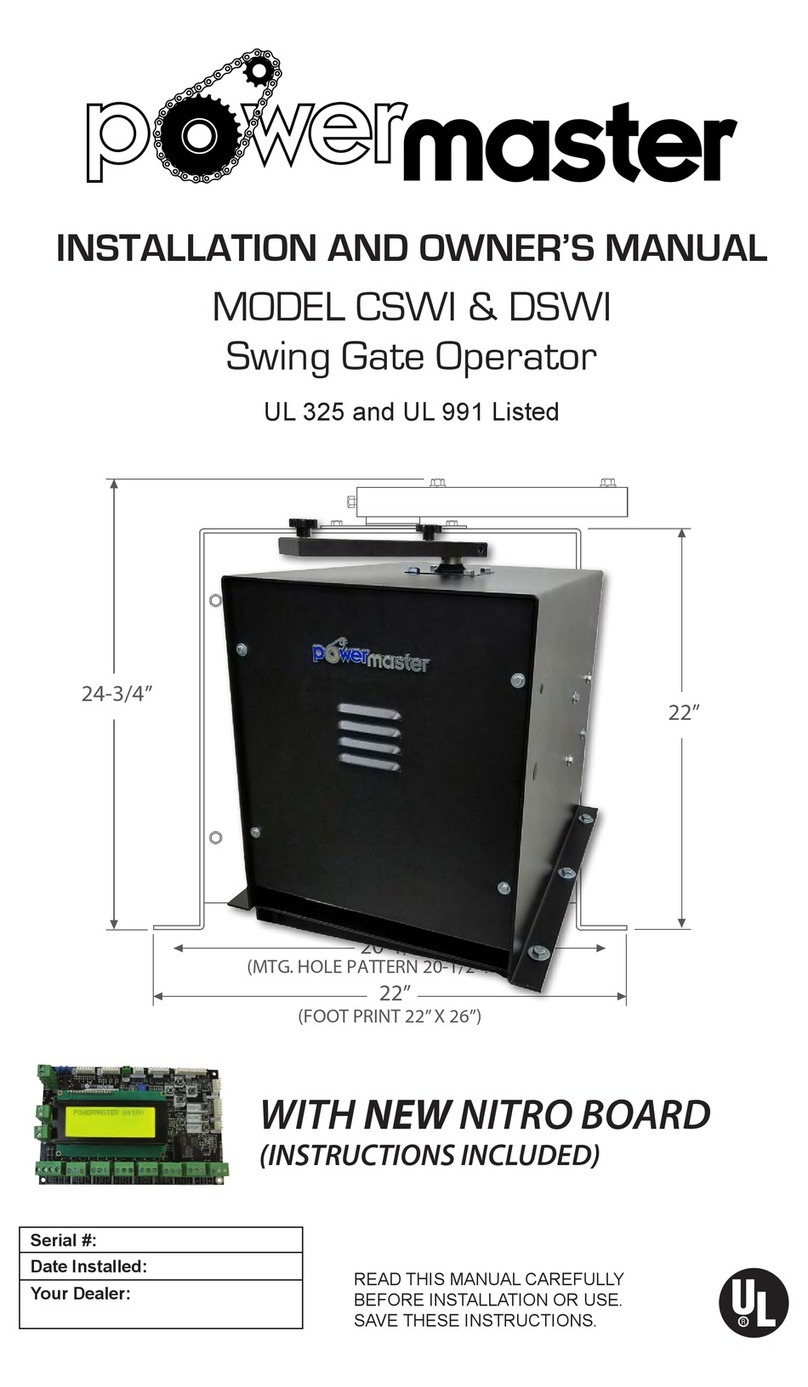
Power Master
Power Master CSWI Installation instructions
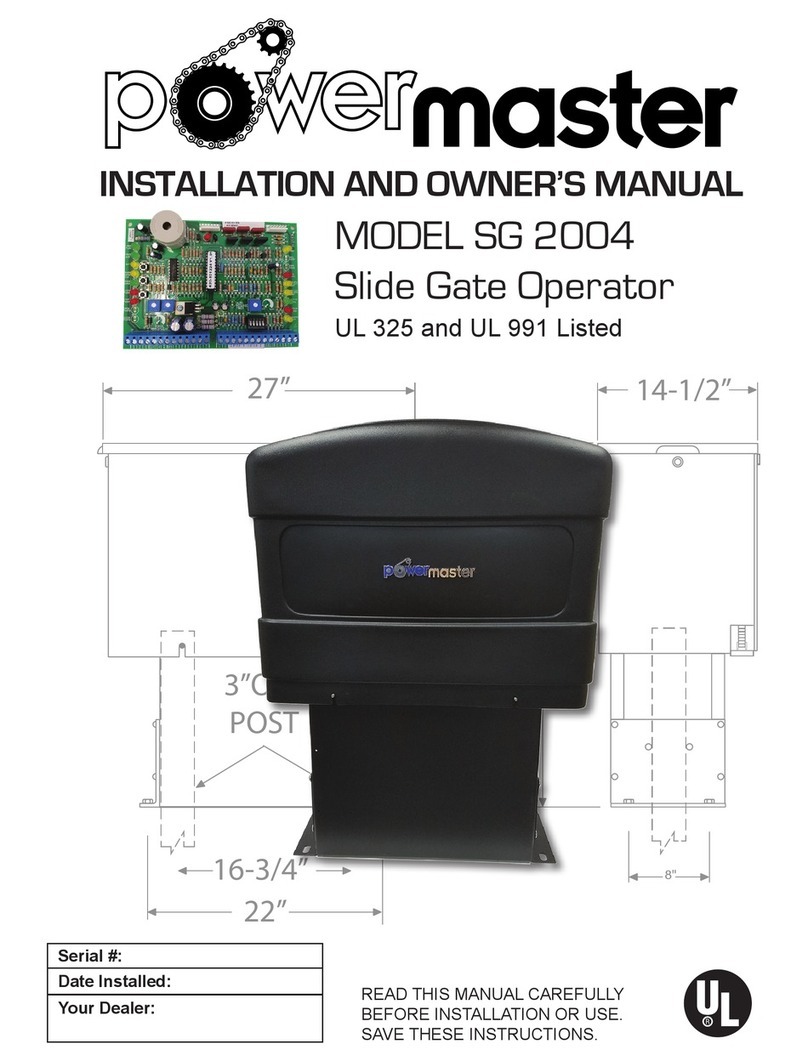
Power Master
Power Master SG 2004 Installation instructions
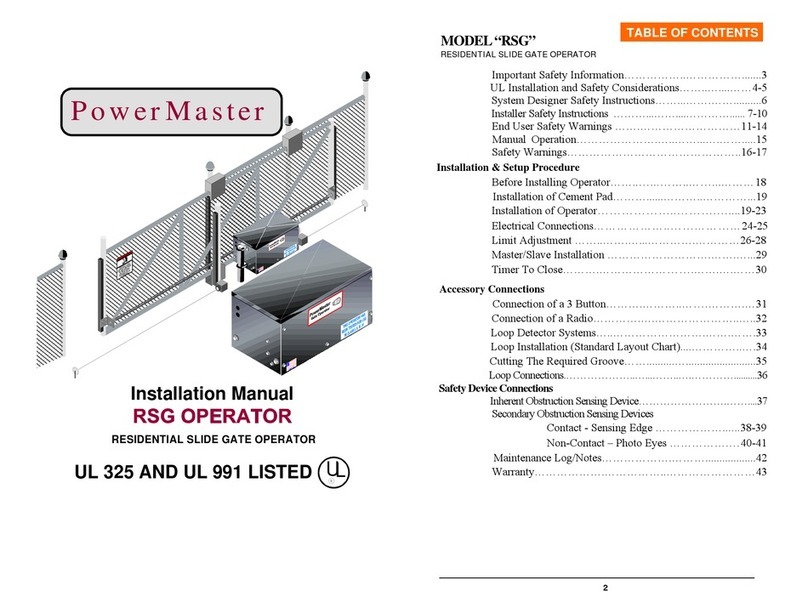
Power Master
Power Master RSG User manual

Power Master
Power Master CSWC User manual
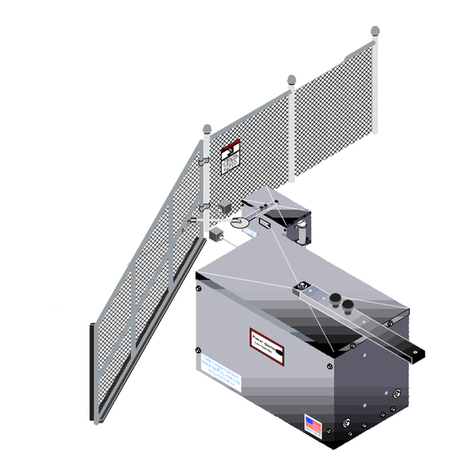
Power Master
Power Master rsw User manual
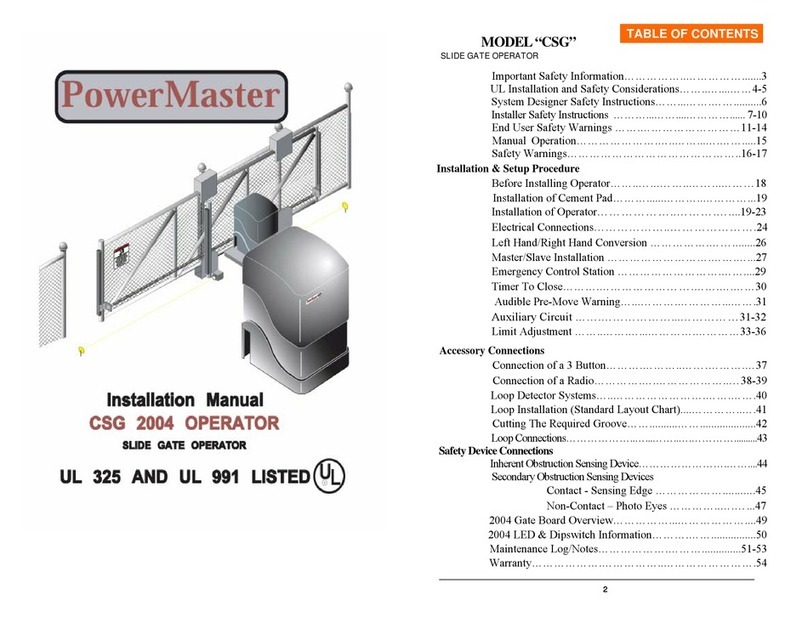
Power Master
Power Master CSG 2004 User manual
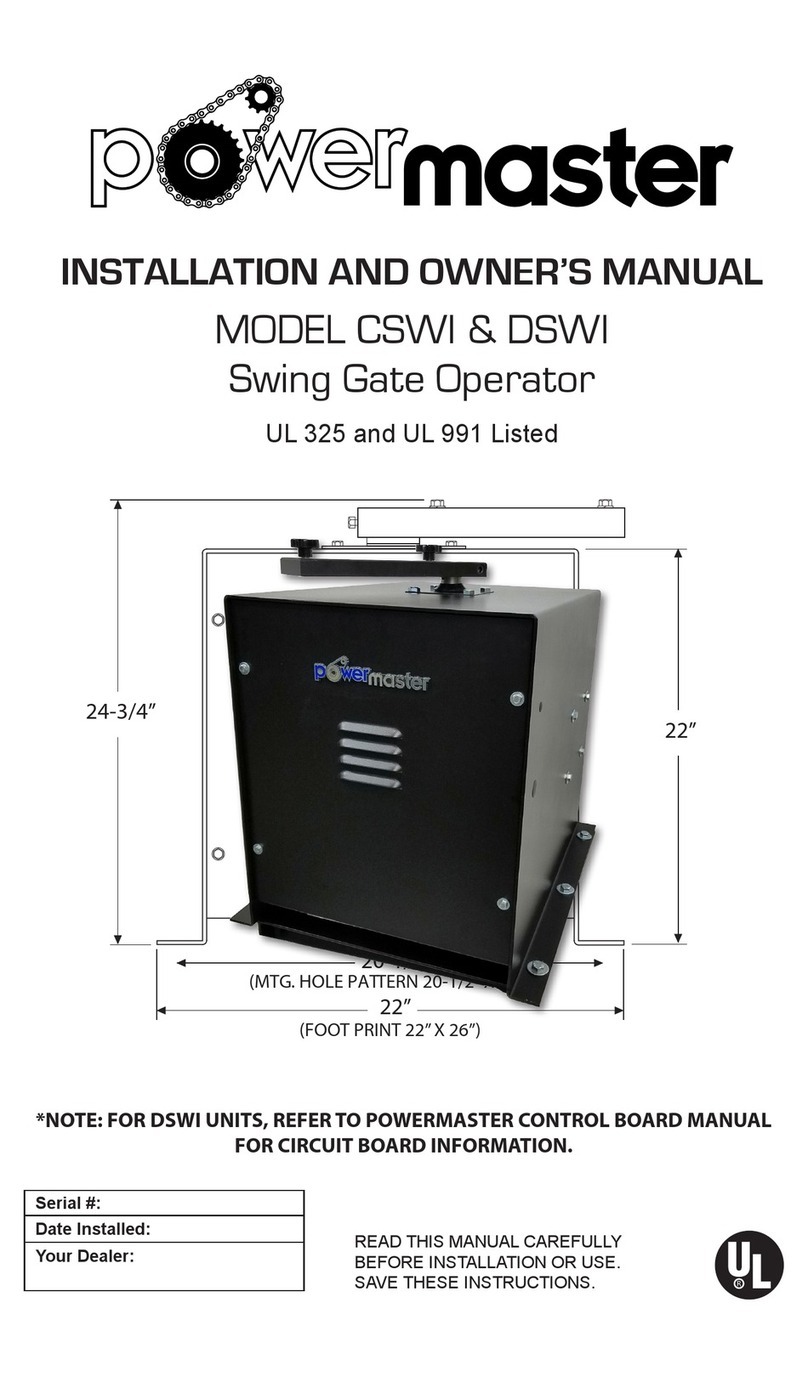
Power Master
Power Master DSWI Installation instructions
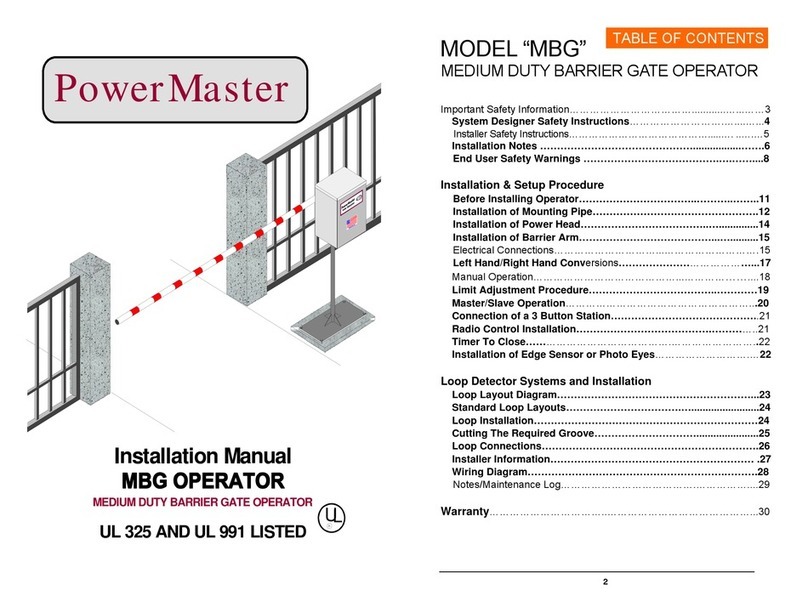
Power Master
Power Master MBG User manual
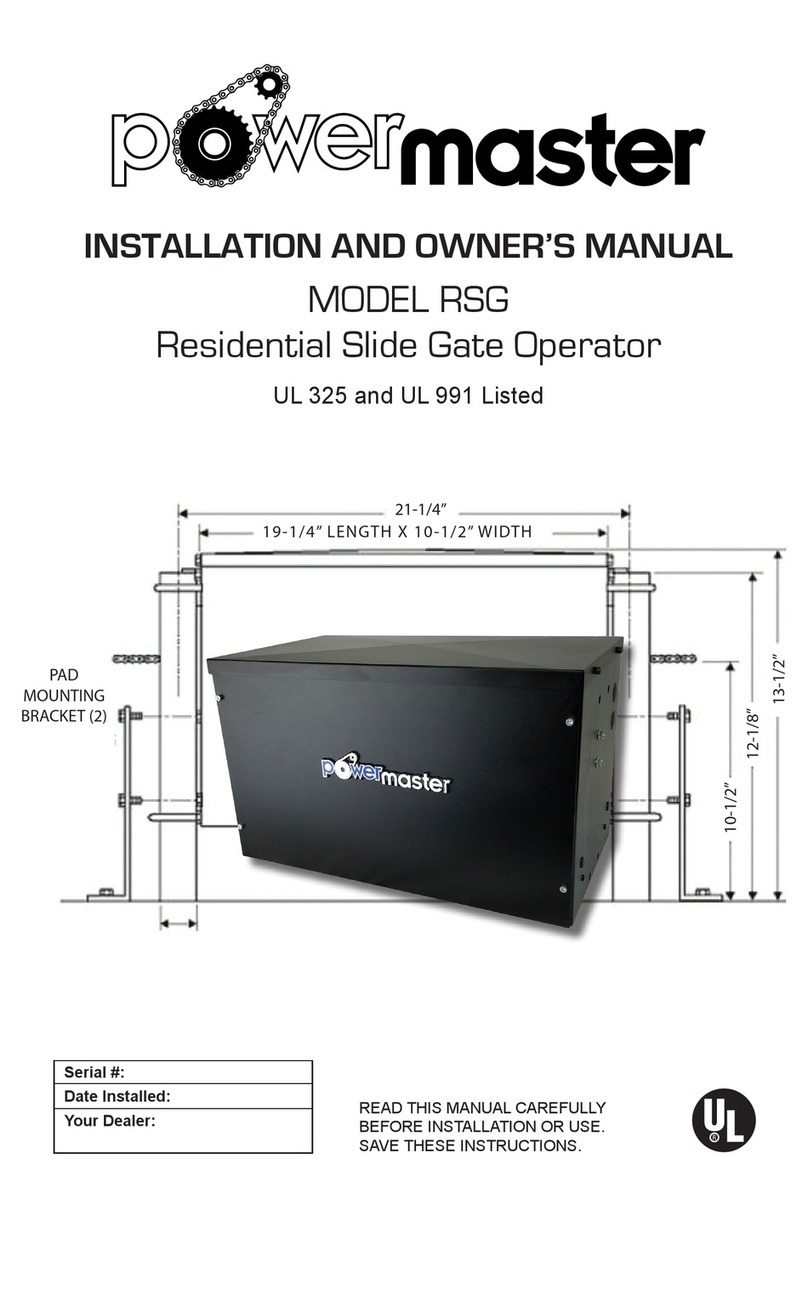
Power Master
Power Master RSG Installation instructions
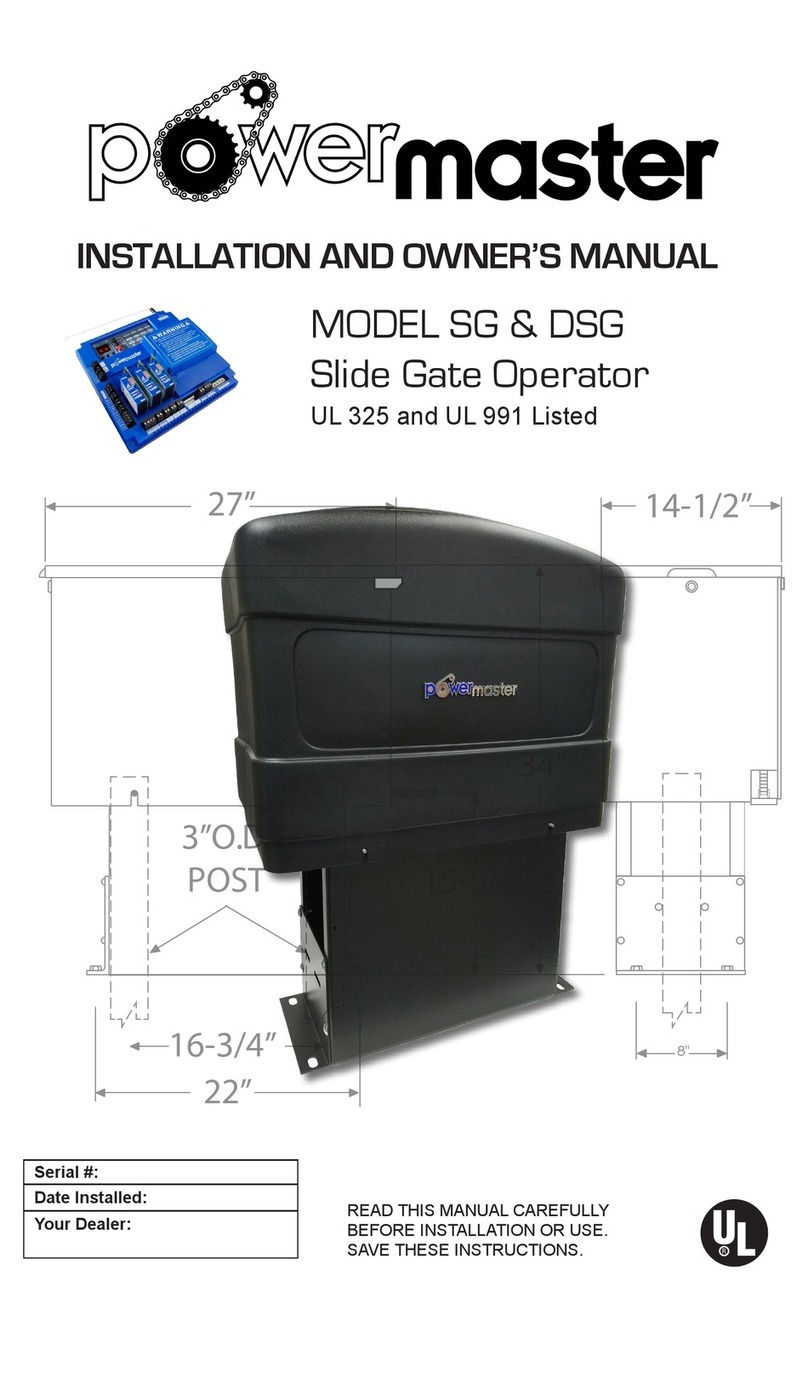
Power Master
Power Master SG Operating instructions
